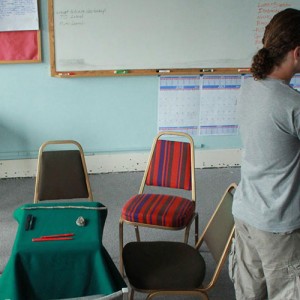45 minutes and 52 seconds.
1. Technique “Tea with Grandma”
2. Technique “Same Conversation”
- Leanne Hinton’s work with the Master/Apprentice system.
- Hang out with your elder, as much as possible, to learn their language.
- It seems to be missing the apprentice’s training in rigorous language hunting to accelerate the acquisition of language from the elder.
- “Tea with Grandma” is the archetypal “same conversation” you would have with your grandma.
- You’re trying to find out some important information: what does grandma like, what does she prefer, in terms of teas, milk/cream, sugar, general likes and preferences and the stories behind them.
- What if grandma doesn’t like milk in her tea, because she is allergic to milk? This could trigger a superior conversation (what if everyone was allergic to milk, how would it change our culture?).
3. Technique “Set-up”
- You’ll use the most obvious props you can, using grandmas preferred set-up as much as possible.
- This could be “Whiskey with Grandma”, or “Diet Coke with Grandma”, it depends on her preferences.
4. Technique “Appreciative Inquiry”
- If I ask you a question about something about something that gives you energy, that you enjoy, you will have more energy to keep talking.
- If I ask you a question about something that drains you, that causes you misery, you will lose energy for conversation.
5. Technique “These are a Few of My Favorite Things”
- Stick to topics and props that give your “fluent fool”, and fellow language hunters, energy and joy.
- Skilled language-hunting looks no different than skilled interviewing.
- You enjoy yourself, grandma enjoys herself, everybody wins.
6. Technique “Start at the Beginning”
- Start by just enjoying time with grandma. Sit with her, have tea, no language hunting (per se), just enjoy the time.
- Look around the room, what does she have out, bowling trophies, tea sets, pictures?
- You’re history hunting, story hunting, before you start pulling language.
- Look for common ground – if you like bowling too, consider next time have the conversation at the bowling alley.
- Start by going to grandma’s house; don’t make her come to you.
- What time of day is she available?
- What time is she napping, or watching TV?
- Evan’s grandmother won a car from Bob Barker on TV’s “the Price is Right”. And then later, he wrecked it: “that brought out some language there..!”.
7. Technique “Craig’s List: Positives’ List”
- Always start with the positive list, before negatives list, in the spirit of appreciative inquiry. There is a list of preferences, favorite, etc.
- Evan and Willem start building the list on the spot.
- “Want, Like, Need, Love, Prefer…”
- Another list: “Prefer, Style, Taste…”
- Another: “Kind, Type, Flavor…”
8. Technique “Obviously”
- Grandma’s favorite tea set is a hippie, tie-dyed, confusing set. You want to save that for a riddle-me-this moment later.
- Bring your own cup, if necessary, your “favorite” one.
- It will be really obvious, because you are a language hunter.
- Obvious props: tiny, tiny tea cup, and a huge cappuccino cup, to hunt “big, small”. All one color, like white.
- Find the easiest color to say, and bring everything in that color.
9. Technique “Modeling”/”You Go First”
- Evan and Willem decided to make workshop attendees experience this archetypal “tea with grandma” set-up.
- Evan plays the last, fluent signer of ASL on the planet, a grandma.
- Willem helps the participants set-up the conversation, and then bring grandma in, and hunt her language.
- Players can only hunt grandma one or two at a time; once they have acquired a small piece of language, they have tea again with a table of fellow hunters, and take “3-D, Holographic Notes”.
- All the props used with grandma, must have exact duplicates to take away to re-experience the conversation.
10. Technique “3-D, Holographic Notes”
- A story of a linguist who couldn’t find a piece of language in a computer/audio database, and Evan’s reaction as a node in the “living, human, 3-D, holographic database”.
- People who hold a target language, in trust, are essentially an immersive, 3-D, holographic, living database: the best documentation that any linguist will ever get.
- The highest quality information will always come from the information held in trust by living people.
- Now, the linguist can take the information he got from Evan, and go ping other speakers (other living databases), to double check, find accent variations, and so on.
- Evan tells a story of learning the meaning of the spanish idiom, “no me da la ganas”, through language hunting.
- To teach Willem the meaning of this phrase, Evan would use the same set-up that he experienced in Mexico, almost like programming a holodeck.
- Set-up a “holodeck” in your home, using the WAYK props, even if it’s just a 12″ square space on a counter.
- You’ll never find the embodied human emotional experience of language in a dictionary.
11. Technique “Language Hunting”
- Language-hunting is a way to re-hydrate what is in a dictionary, turn it back into embodied human interaction.
- Find words in the dictionary that you need to know, and use them as “questions” (technique “make me say…”, “correction response”) to hunt grandma with.
- Teach off your language as soon as possible to someone else, then they can start having tea (“same conversation”) with grandma too, accelerating the amount, and accuracy, of the language you hunt.






I just went back and reread the original message W&E wrote last November. I totally didn’t understand the plan back then. I am happy I was able to get up to Want/Have/Give/Take with her, but with what I know now, I could have gotten much further! WAYK must spread!
For folks who are interested, the links are:
http://whereareyourkeys.org/2009/11/09/language-hunting/
http://whereareyourkeys.org/2009/11/09/language-hunting-2-evans-response/